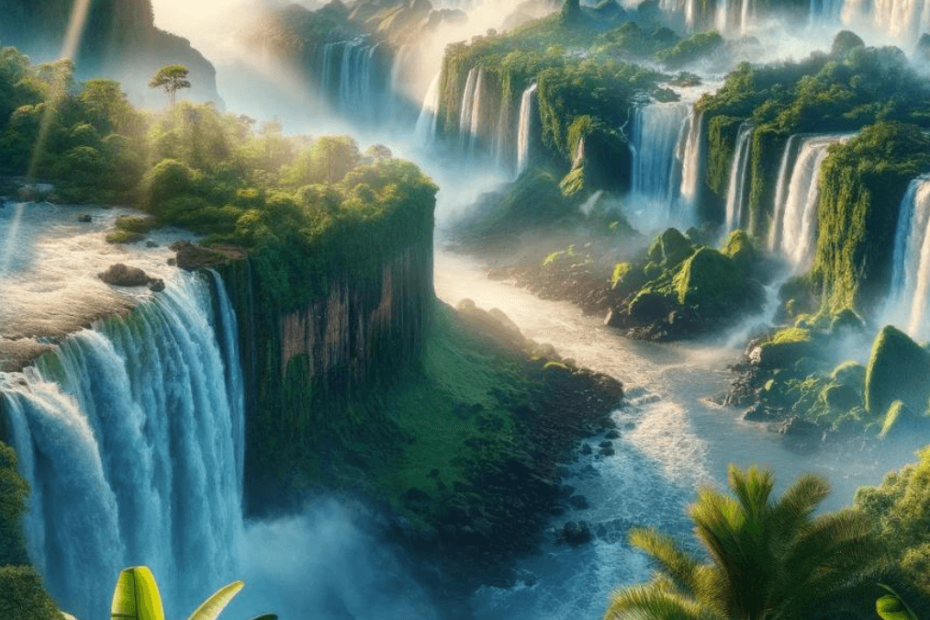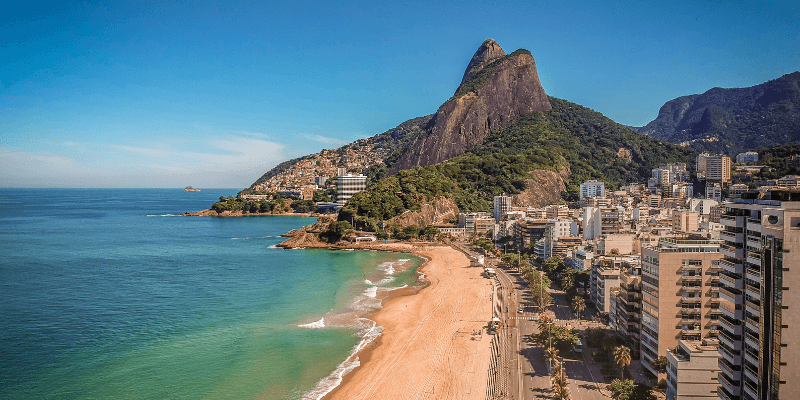- Explore the breathtaking Iguazu Falls in Brazil, a natural marvel on the border with Argentina.
- Discover essential travel tips, how and where to buy your tickets, how to get to the falls, best visiting times, and conservation efforts.
- Experience unique adventures beyond the falls, including wildlife encounters and cultural insights.
Welcome to the heart of Brazil’s natural wonders, where the majestic Iguazu Falls in Brazil reign supreme. Imagine a place where hundreds of cascading waterfalls create a spectacle of beauty, power, and awe, unlike anything you’ve ever seen.
Having been born and raised here in Brazil, I grew up hearing about the Iguazu Falls, even more so living in Paraná, the state where it is located. I’ve been there a few years ago, and it’s certainly one of the most spectacular places we have here
This comprehensive guide is your personal invitation from a local Brazilian enthusiast, eager to share the magic of these falls, nestled on the border of Brazil and Argentina.
Through this journey, you’ll discover not just the breathtaking views and thrilling sounds of the falls but also dive deep into the rich culture, vibrant ecosystems, and the warm hospitality that Brazil is celebrated for.
So, grab your virtual backpack, and let’s embark on an unforgettable adventure to the Iguazu Falls, a true marvel of our beautiful country.
Introduction to Iguazu Falls in Brazil
Nestled in the lush landscapes where Brazil meets Argentina, Iguazu Falls stands as a breathtaking testament to the awe-inspiring beauty of nature.
For those of us lucky enough to call Brazil home, Iguazu Falls is a source of national pride and a reminder of the incredible diversity our country holds.
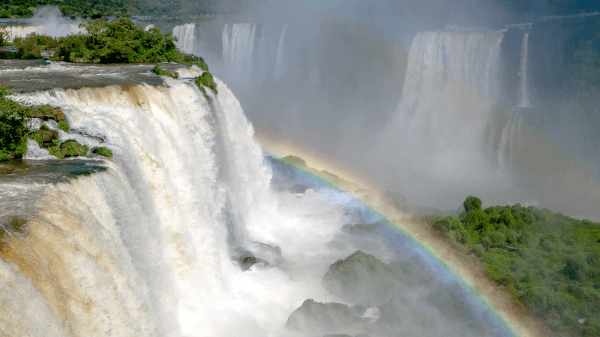
Is the Iguazu Falls on Argentina or Brazil side?
A question that often puzzles our visitors is where exactly Iguazu Falls is located. Is it in Brazil or Argentina? Well, the answer is both!
The falls stretch across the border of the Brazilian state of Paraná and the Argentine province of Misiones.
While Argentina hosts a larger portion of the falls, the Brazilian side offers unparalleled panoramic views that are nothing short of spectacular.
From Brazil, you can soak in the vast expanse of cascades, getting a sense of their grand scale and the power of the Iguazu River as it plunges into the gorge below.
- Find the cheapest flights
- Discover the best accommodation
- Explore this incredible country with the best experiences
- Stay connected at all times with an eSIM
What is special about the Iguazu Falls in Brazil?
But what makes Iguazu Falls so special? Beyond its stunning beauty and impressive size, Iguazu Falls is a place where nature’s force is on full display.
With around 275 waterfalls spread over nearly 3 kilometers, it’s the largest waterfall system in the world.
The falls’ crown jewel, the Devil’s Throat, creates a thunderous roar and a mist that can be seen from miles away. This natural marvel isn’t just about the water; it’s about the rich biodiversity that thrives in its lush rainforest.
Home to countless species of flora and fauna, some of which are unique to the region, Iguazu Falls is a living, breathing showcase of ecological diversity and a testament to the beauty and power of our natural world.
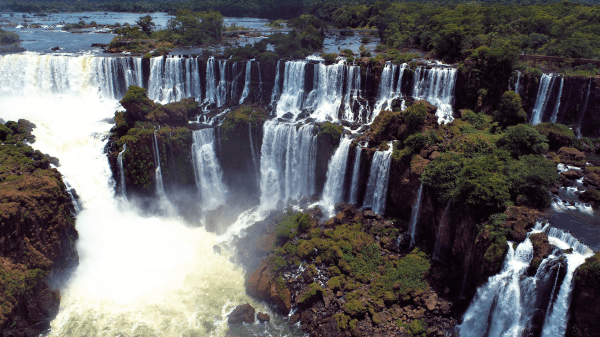
Also See | Brazil Beach Ipanema: Discover One of The Most Famous Brazilian Attractions
The Geography and Natural Splendor of Iguazu Falls
Tucked away in the serene embrace of the Paraná Plateau, Iguazu Falls in Brazil stands as a testament to the breathtaking beauty that emerges at the confluence of Brazil and Argentina.
The falls are cradled by the Iguazu River, which meanders through Brazil before unveiling its grandeur at the precipice of the falls, a spectacle that captures the essence of South America’s natural splendor.
Geological Marvels and Water Flow
Iguazu Falls is a geological marvel, centuries in the making.
The story of its formation is as captivating as the falls themselves, beginning with volcanic activity that laid down layers of basalt rock.
Over time, the relentless force of water carved out the falls, creating a spectacular display of cascades.
The water flow at Iguazu is a powerful force, varying with the seasons. During the rainy season, the river swells, and the falls transform into an even more magnificent torrent, with the water’s roar echoing through the rainforest.
This dynamic flow shapes the landscape, constantly redefining the contours of the falls and the surrounding area, making each visit to Iguazu a unique experience.
Flora and Fauna Around the Falls
The area around Iguazu Falls in Brazil is a vibrant tapestry of biodiversity. The lush rainforest that envelops the falls is part of the larger Atlantic Forest, a biome known for its rich biodiversity and high number of endemic species.
This verdant backdrop is home to an astonishing variety of life, including over 2,000 plant species, which create a green sanctuary around the water’s edge.
Orchids and bromeliads add splashes of color, while ancient trees tower overhead, their canopies teeming with life.
The fauna of Iguazu is as diverse as its flora. The dense foliage hides jaguars, tapirs, and ocelots, while the skies are ruled by over 400 species of birds, including the colorful toucan with its iconic bill.
The area is also a haven for butterflies, adding a fluttering layer of beauty to the falls.
This incredible biodiversity not only makes Iguazu Falls a natural wonder but also a critical area for conservation efforts, as it represents one of the last remnants of the Atlantic Forest’s rich ecosystems.
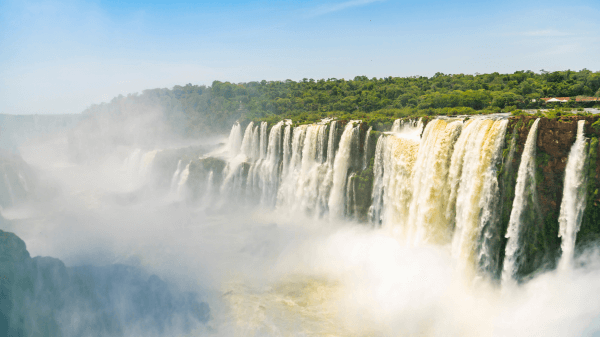
Historical Significance of Iguazu Falls
The falls have been a site of awe and inspiration long before they were discovered by European explorers, deeply rooted in the rich tapestry of indigenous cultures and legends that predate modern boundaries.
This section delves into the historical significance of Iguazu Falls, exploring the early explorations that brought it to the world’s attention and the indigenous myths that continue to shape its mystique.
Early Explorations and Naming
The history of Iguazu Falls is as captivating as its beauty. The first European to lay eyes on this natural wonder was the Spanish explorer Álvar Núñez Cabeza de Vaca in 1541, during his expedition in search of the fabled City of Gold.
He named the falls “Santa María,” a name that eventually faded into obscurity as the local Guarani name, “Iguazu,” took precedence.
Iguazu translates to “big water” in the Guarani language, a fitting descriptor for the vast and powerful cascade.
This encounter marked the beginning of the falls’ global recognition, drawing explorers and adventurers from around the world to witness its majesty.
Indigenous Legends and European Encounters
Long before European explorers arrived, Iguazu Falls in Brazil was steeped in the mythology of the indigenous Guarani people.
One legend tells of a deity who, angered by a mortal’s betrayal, sliced the river, creating the falls and condemning the lovers to an eternal fall.
You can learn a little more about this legend in the video below:
Such tales speak volumes about the cultural significance of the falls to the indigenous people, for whom it was a site of spiritual reverence and a testament to nature’s power.
The encounter between European explorers and indigenous peoples at Iguazu Falls is a pivotal chapter in the region’s history, reflecting a period of change, discovery, and ultimately, the blending of cultures.
These interactions brought Iguazu Falls into the annals of global natural wonders, making it a symbol of exploration and the enduring allure of the unknown.
Also See | Where is the Amazon Rainforest in Brazil? And 8 Other Answers About the Forest
Visiting Iguazu Falls: A Tourist’s Guide
Whether you’re a seasoned traveler or planning your first adventure to this natural wonder, having the right information can make your visit truly unforgettable.
From navigating your way to the falls to choosing the perfect time to visit, and exploring the myriad of experiences awaiting you, this guide is your go-to resource for making the most of your trip to Iguazu Falls.
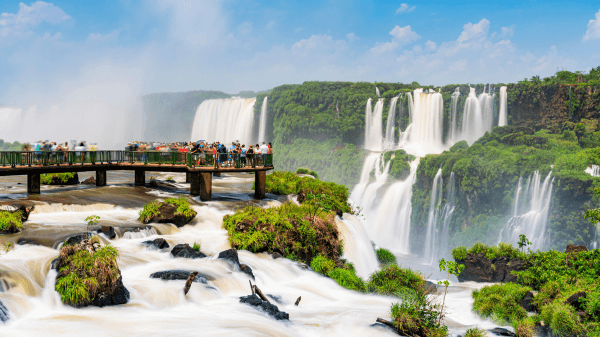
How do you get to Iguazu Falls in Brazil?
To get to the Iguazu Falls, you must first get to the base city where the park is located, called Foz do Iguaçu.
Discover the best accommodation in Foz do Iguaçu
Foz do Iguaçu is a city that relies heavily on tourism because of the falls, so it is well equipped with hotels and hostels and a good infrastructure of tours that go beyond the falls.
By Plane
The easiest way to get to the city of Foz do Iguaçu (or simply “Foz” as we call it around here) is by taking a flight to its airport.
The main airlines in the country make this journey: LaTam, Gol and Azul.
The cities from which the most frequent flights to Foz do Iguaçu depart are: São Paulo (1h40m trip), Curitiba (1h15m trip) and Rio De Janeiro (2h15m trip).
By Bus
If you can’t take a plane, there is also the option of getting to Foz by bus.
From Curitiba, the capital of the state of Paraná, where the Falls are located, you can take a bus from the Catarinense company, which takes just over 10 hours to reach Foz.
From São Paulo, you can take a Pluma bus, which takes around 18 hours to reach Foz.
Arriving at the falls park
Once in Foz do Iguaçu, it will be easy to get to the falls. Your next destination is the Iguaçu National Park, a reserve that encompasses the falls and all around them.
The park entrance is 14 km from the center of Foz.
To get there you can take: a municipal bus (line 120), shared transportation offered by agencies (around R$45.00) that picks you up at your hotel, call an uber or taxi.
Once inside the park, you will have to board a bus that is already included in the ticket price, which will cross a beautiful forest and take you close to the Iguassu Falls in Brazil.
Also See | 20 Songs to Know The Best of Tradicional Brazilian Music
Tickets and Tours: Pricing and Options
Tickets for Iguassu Falls in Brazil are only sold online on the Iguaçu National Park website.
The prices for 2024 are:
- R$100.00 for foreigners;
-
- R$91.00 for Brazilians or citizens of countries that are part of Mercosul;
- Children up to 6 years old are free.
Additionally, the park offers a range of guided tours:
- Walking tours at dawn, during sunset and at night;
What time does the Iguazu Falls open in Brazil?
Monday to Friday: 9 a.m. to 4 p.m.
Saturday and Sunday: 8:30 a.m. to 4 p.m.
4 p.m. is the time the park entrance closes, you can stay inside until 5:30 p.m., when the last bus returns to the park entrance.
Best Times to Visit and Weather Conditions
Timing is everything when it comes to experiencing Iguazu Falls in Brazil in all its glory.
The falls are a year-round destination, but the best time to visit is during the spring (September to November) and autumn (March to May) months.
These periods offer pleasant weather, fewer crowds, and the perfect balance between the volume of water and visibility of the falls.
The summer months (December to February) bring heavy rains, which can significantly increase the water flow, making the falls even more spectacular but also more crowded.
On the other hand, winter (June to August) is drier, offering clearer views but with less water volume.
Unique Experiences at Iguazu Falls
The Iguaçu National Park is the only way to get to the falls on foot, but you can also take other tours offered by local agencies that leave from outside the park, but come close to the falls.
Take the Macuco Safari, an exhilarating boat ride that takes you right to the base of the falls, offering a perspective like no other.
For a bird’s-eye view, consider a helicopter tour that reveals the grandeur of the falls in all its sprawling majesty.
Nature lovers will relish the opportunity to explore the surrounding rainforest, home to an array of exotic wildlife and vibrant flora.
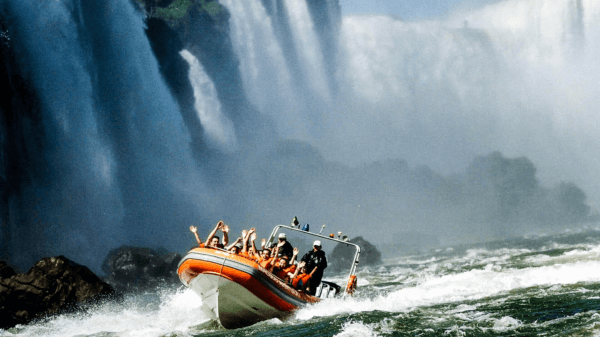
The Parks of Iguazu: Conservation Efforts and Tourism Impact
Both the Brazilian and Argentine sides of Iguazu Falls have been designated UNESCO World Heritage Sites, a recognition that speaks volumes about their global significance and the collective responsibility to protect these natural treasures.
As we explore the parks and their conservation efforts, it’s crucial to understand the delicate balance between welcoming tourists and safeguarding the environment.
Iguazu National Park in Brazil
On the Brazilian side, the Iguazu National Park serves as a sanctuary not just for the falls themselves but for a rich biodiversity that thrives in its Atlantic rainforest ecosystem.
Established in 1939, the park covers an expansive area, ensuring protection for countless species of flora and fauna, some of which are endemic to the region.
The Brazilian park offers panoramic views of the falls, allowing visitors to grasp the scale of this natural wonder while minimizing human impact on the most sensitive areas.
Efforts in Brazil have focused on sustainable infrastructure, such as eco-friendly walkways that prevent soil erosion and allow wildlife to move freely, and educational programs aimed at raising awareness about the importance of conservation among visitors.

Conservation Initiatives and Sustainable Tourism
The challenge of preserving Iguazu Falls in Brazil amid growing tourist interest has led to innovative conservation initiatives on both sides of the border.
Sustainable tourism practices are at the heart of these efforts, ensuring that the awe-inspiring beauty of the falls can continue to be enjoyed without compromising the ecological integrity of the parks.
Measures include strict visitor limits in sensitive areas, the promotion of eco-friendly tours, and significant investment in research and monitoring programs to study the impact of human activity on the local environment.
Additionally, both parks have engaged in reforestation projects to restore areas affected by past deforestation, enhancing the habitat for the diverse wildlife that calls the parks home.
Beyond the Falls: Activities and Attractions
Exploring Iguazu Falls is an unforgettable adventure, but the journey doesn’t end at the water’s edge.
The area surrounding the falls is rich with additional attractions and activities that promise to enrich your visit.
From up-close encounters with exotic wildlife to adrenaline-pumping tours and dives into the deep pool of local culture and history, there’s a whole world beyond the falls waiting to be discovered.
The Bird Park and Other Wildlife Encounters
Just outside the Iguazu National Park, the Parque das Aves (Bird Park) offers a sanctuary for bird lovers and wildlife enthusiasts.
This internationally recognized conservation facility is home to more than 150 species of birds, including the vibrant toucans, majestic harpy eagles, and playful parrots, many of which are rescued and rehabilitated.
Walking through the immersive aviaries, you’re not just observing; you’re stepping into the birds’ world.
Beyond birds, the park also provides sanctuary to butterflies, reptiles, and other rainforest creatures, making it a must-visit for anyone wanting to connect with the diverse fauna of the region.
Adventure Tours and Helicopter Rides
For those seeking a thrill, the area around Iguazu Falls in Brazil doesn’t disappoint.
Embark on an adventure tour that takes you rafting on the Iguazu River’s rapids, trekking through the lush rainforest, or rappelling down the canyon walls for an adrenaline rush with a backdrop of breathtaking scenery.
For a bird’s-eye view of the falls, helicopter rides offer an unparalleled perspective. Soaring above the cascades, you can appreciate the vastness of this natural wonder—a truly once-in-a-lifetime experience that presents the falls in all their majestic glory.
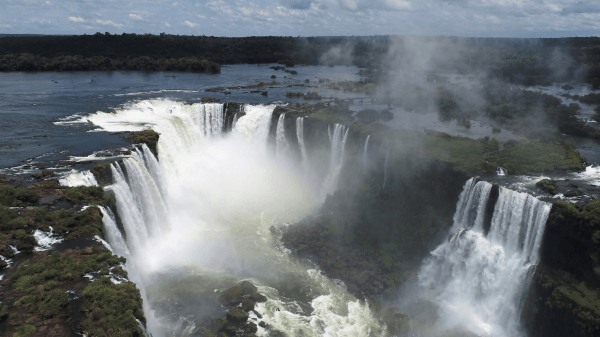
Cultural and Historical Sites Nearby
The region’s rich tapestry is woven with vibrant cultural threads and historical strands that extend beyond the natural allure of the falls.
The Ecomuseum of Itaipu, for example, offers insights into the history of the Itaipu Dam and the region’s indigenous cultures, while the Marco das Três Fronteiras marks the point where Brazil, Argentina, and Paraguay meet, offering a unique cultural experience and stunning views at sunset.
Additionally, the Jesuit Missions on the Argentine side, though a bit of a journey, provide a fascinating glimpse into the area’s colonial past, showcasing the complex history and enduring spirit of the local Guarani communities.
Iguazu Falls in Comparison: Niagara and Victoria Falls
When it comes to the world’s most magnificent waterfalls, Iguazu Falls stands tall alongside other iconic cascades such as Niagara Falls in North America and Victoria Falls in Africa.
Each of these natural wonders has its unique allure, drawing visitors from around the globe.
A comparative analysis reveals just how Iguazu Falls in Brazil distinguishes itself not only in sheer size and flow but also in its approach to conservation and global recognition.
Size, Flow Rate, and Visitor Experience
Iguazu Falls in Brazil, with its impressive array of 275 individual cascades spread across a 2.7-kilometer expanse, outmatches Niagara’s more concentrated flow and Victoria’s singular, vast curtain of water.
The flow rate of Iguazu can reach up to 6,500 cubic meters per second during the rainy season, rivaling that of Niagara and surpassing Victoria’s average.
However, it’s the visitor experience where Iguazu truly shines.
The falls are enveloped by the lush Atlantic rainforest, offering a multitude of vantage points from both the Brazilian and Argentine sides.
This provides a more immersive experience, allowing visitors to feel intimately connected with the natural environment in a way that’s distinct from the more urban settings of Niagara or the remote, raw nature of Victoria.
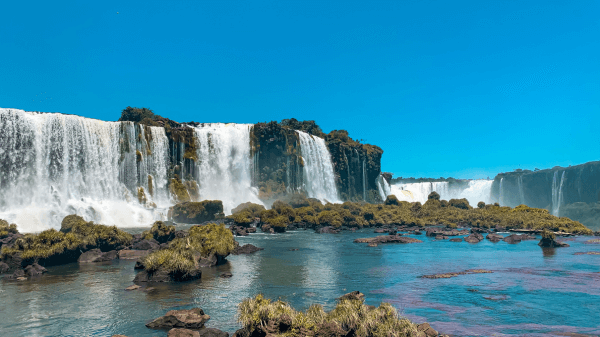
Conservation Status and Global Recognition
In terms of conservation and global recognition, all three waterfalls are celebrated for their ecological and cultural significance, but Iguazu Falls enjoys the distinction of being part of two UNESCO World Heritage Sites, emphasizing its importance in both Brazil and Argentina.
This dual recognition underscores a commitment to preserving the unique biodiversity of the surrounding rainforest, which houses thousands of species of flora and fauna.
Efforts to balance tourism with environmental preservation at Iguazu are evident in the carefully managed visitor access and sustainable tourism practices, setting a benchmark for natural attractions worldwide.
Essential Tips for Visitors
To ensure that your experience is as memorable and smooth as possible, it’s crucial to come prepared and to approach this natural wonder with the respect it deserves.
Here are some essential tips to help you make the most of your visit while preserving the beauty of Iguazu Falls for future generations.
What to Bring and Wear
The key to enjoying Iguazu Falls in Brazil is comfort and preparedness.
Given the tropical climate, lightweight, breathable clothing is a must.
Expect warm, humid weather, but be ready for rain showers, which can occur unexpectedly.
A waterproof jacket or poncho can be a lifesaver, keeping you dry during boat tours or sudden downpours.
Comfortable, water-resistant footwear is essential, as you’ll be walking on wet and possibly slippery paths.
Don’t forget a hat and sunglasses to protect against the sun, along with sunscreen, even on cloudy days.
Equally important is to carry a reusable water bottle to stay hydrated throughout the day without contributing to plastic waste.
For capturing the stunning views, bring a camera or smartphone, ideally with a waterproof case or bag for protection.
Lastly, considering the lush surroundings and proximity to water, insect repellent is a must to keep pesky mosquitoes at bay, ensuring a more enjoyable experience.
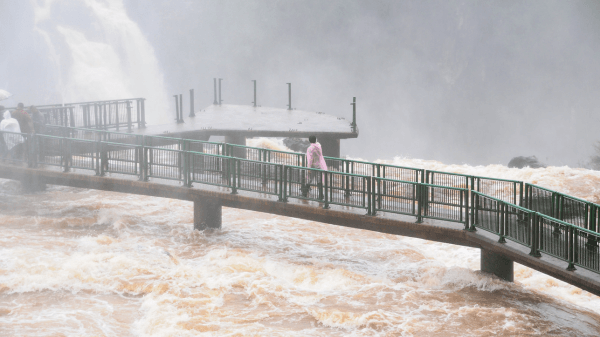
Safety Guidelines and Respect for Wildlife
Iguazu Falls is not just a tourist destination; it’s a vibrant ecosystem home to countless species of plants and animals.
Respecting wildlife is paramount—feeding or attempting to touch the animals, including the coatis that roam the park, can be harmful to their health and alter their natural behaviors.
Always maintain a safe distance, and use binoculars or a camera zoom to observe them closely.
Adhering to safety guidelines is crucial for a safe visit.
Stay within designated pathways and viewing platforms to avoid accidents and minimize environmental impact.
Guardrails and signs are there for your protection; climbing over them for a better photo is dangerous and damages the site.
Additionally, listen to park rangers and guides; their expertise and advice are invaluable for a safe and fulfilling visit.
By following these essential tips and approaching your visit with mindfulness and respect for nature, you’ll not only ensure a remarkable experience at Iguazu Falls but also contribute to the preservation of this incredible natural wonder for the enjoyment of future visitors.
The Eternal Splendor of Iguazu Falls in Brazil
The Iguazu Falls in Brazil, with their thunderous roar and misty rainbows, stand as a testament to the eternal splendor of nature.
This natural masterpiece, straddling the border between Brazil and Argentina, transcends mere geographical boundaries, uniting all who visit in a shared sense of wonder and awe.
Its cultural significance, deeply rooted in indigenous lore and global recognition, adds layers of richness to the visitor experience, reminding us of our place within the natural world.
As we marvel at the falls’ majestic beauty, we are also called to the vital task of preservation, ensuring that future generations can witness this spectacle just as we have today.
In embracing the spirit of conservation and sustainable tourism, we honor the legacy of Iguazu Falls, a treasure of our planet that continues to inspire and humble us with its eternal splendor.
Did you like our content, do you want to get to know our country?! Discover the best experiences to live in Brazil!
